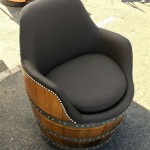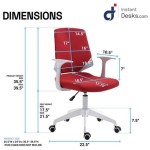Good Lumbar Support Office Chair
Extended periods of sitting, especially in office environments, can significantly impact spinal health. A primary concern is the strain placed on the lumbar region, the lower back area. Choosing an office chair with adequate lumbar support is crucial for mitigating this strain and promoting long-term well-being. This support helps maintain the natural inward curve of the lower spine, reducing pressure on the discs and surrounding muscles. This article examines the importance of lumbar support in office chairs and discusses key features to consider when selecting one.
Adjustable Lumbar Support
The ability to adjust the lumbar support is a critical feature. Individuals have varying body types and spinal curvatures, necessitating personalized adjustments. An adjustable lumbar support mechanism allows users to fine-tune the chair to their specific needs, ensuring optimal comfort and support. This adjustability can involve modifying the height and depth of the lumbar support, allowing for precise positioning to match the individual's lower back curvature.
Adjustable lumbar support systems can take various forms, from inflatable air bladders to adjustable straps and ratcheting mechanisms. Inflatable systems allow users to control the firmness of the support, while adjustable straps and ratcheting mechanisms allow for precise height and depth adjustments. The best option depends on individual preferences and needs.
Built-in Lumbar Support vs. Add-on Support
Office chairs can offer lumbar support through built-in mechanisms or via add-on accessories. Built-in support is often integrated into the chair's design, providing a seamless and aesthetically pleasing solution. These built-in systems can be more robust and are specifically designed for the chair, ensuring compatibility and effective support. However, they may offer less flexibility in terms of customization compared to add-on options.
Add-on lumbar support cushions or pillows can be a cost-effective way to enhance the ergonomics of an existing chair. These accessories are available in various shapes, sizes, and materials, allowing users to choose the best fit for their needs. However, it's crucial to select a high-quality add-on support that provides adequate firmness and stability to maintain proper posture. Poorly designed add-ons can slip, slide, or lose their shape over time, diminishing their effectiveness.
Materials and Construction
The materials used in the lumbar support and the overall chair construction play a significant role in comfort and durability. High-density foam is a common material used in lumbar support systems due to its ability to provide firm yet comfortable support. Memory foam is another popular option, conforming to the individual's body shape for personalized support. However, memory foam can sometimes retain heat, which may be uncomfortable for some users.
The chair's frame construction also influences its long-term durability and stability. A sturdy frame, typically made of metal or high-quality plastic, can provide better support and prevent the chair from wobbling or breaking down over time. The upholstery should be breathable and durable to withstand daily use. Mesh fabrics offer excellent breathability, while leather and high-quality synthetic materials provide durability and a professional appearance.
Ergonomic Considerations Beyond Lumbar Support
While lumbar support is crucial, it's important to consider other ergonomic features for optimal comfort and posture. Seat height and depth adjustability allow users to position their feet flat on the floor, promoting good posture and reducing pressure on the thighs. Armrests should be adjustable to provide support for the forearms and reduce strain on the shoulders and neck. A chair with a tilt mechanism allows users to recline slightly, relieving pressure on the spine and promoting better circulation.
Integrating these additional ergonomic considerations, along with proper lumbar support, contributes to a healthier and more comfortable work environment, ultimately boosting productivity and reducing the risk of musculoskeletal issues. Choosing a chair that addresses these multiple ergonomic factors is an investment in long-term health and well-being.
Testing and Trial Periods
Whenever possible, testing an office chair before purchase is highly recommended. Sitting in the chair for an extended period allows individuals to assess the effectiveness of the lumbar support and the overall comfort of the chair. This hands-on experience can help identify potential issues with the chair's design or adjustability. Furthermore, inquiring about trial periods or return policies allows for a more informed decision and ensures satisfaction with the chosen chair.

We Picked The Best Office Chair For Back Pain At Every Price

Buy Savya Home Zenith Ergonomic High Back Chair For Office Study Table With Recline Height Adjustable Cushion Seat Headrest Grey Online At Best Prices In Jiomart

Hinomi X1 Ergonomic Office Chair With 3d Lumbar Support Leg Rest Gaming Features And 6d Armrest

Best Office Chair For Back Pain In 2024

Lumbar Support Office Chair At 3050 Piece Low Back Chairs In Mumbai Id 2852645796155

Top Solutions For Every Need Lower Backrest Cushion Office Chair Lumbar Support Back Sofa Car Buy

Gharnish Revolving Office Chair With Back Support Hyderabad Ghofc03

Best Executive Chair With Lumbar Support

Buy Classela Executive Ergonomic High Back Chair With Adjustable Height Office Computer Push Tilt Feature Study Chairs Black Jd 01 Online At Best Prices In Jiomart

Chair Garage Pu Leatherette Black Adjustable Height Office With Back Support Cg156








